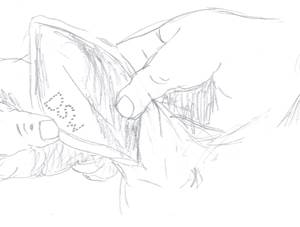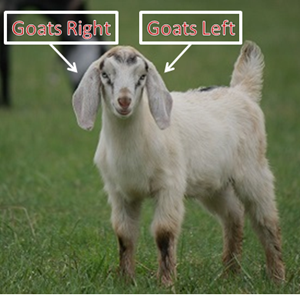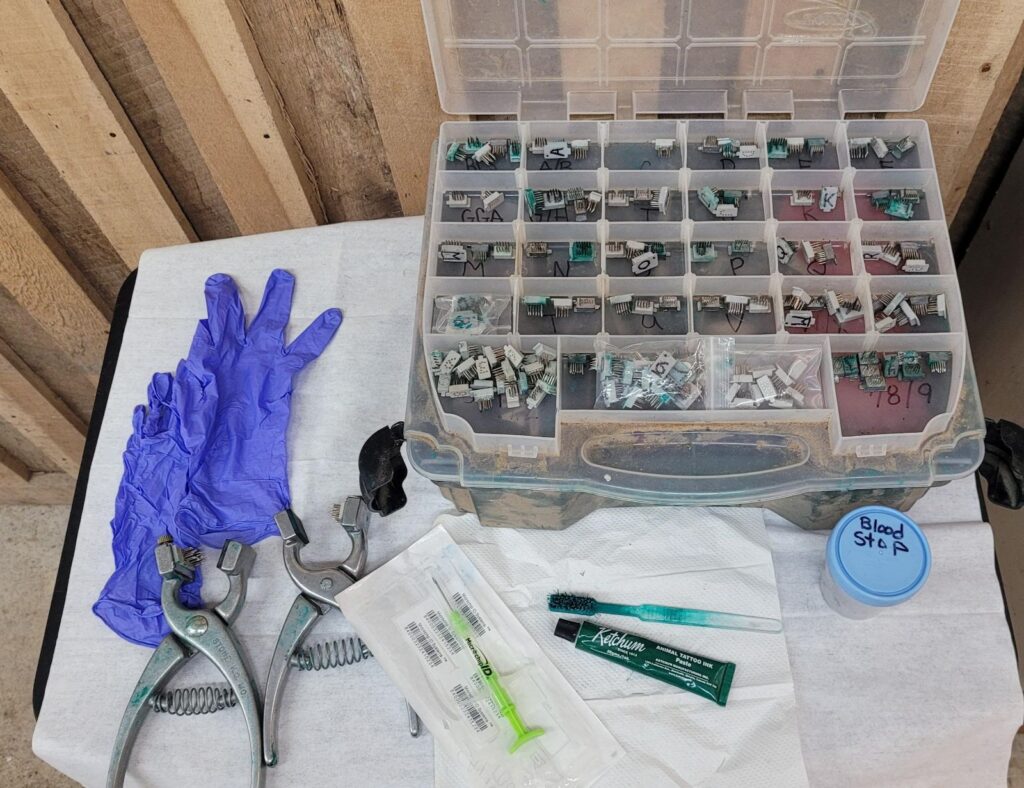MDGA is currently reviewing the Tattoo/Microchip policy to ensure that we follow all USDA policies
To be accepted into registration, an animal must be tattoo’d with the appropriate herd and year tattoo. You must use the tattoo that was chosen when your membership was set-up for all kids born on your property. The herd tattoo assigned to a kid is determined by the property it is born on. Animals should be tattoo’d before they are sold or leave your farm. This tattoo will be the permanent identification for your animal to be used in MDGA programs and transportation of your animal.
Tattoos are placed in both ears of a goat, except for the Mini Lamancha, in which case they are then placed in the tail. The assigned herd tattoo is placed in the RIGHT ear or the RIGHT or CENTER tail. The tattoo used for individual identification for the goat is placed in the LEFT ear or the LEFT or CENTER tail.
How to Tattoo A Dairy Goat
Tattooing a goat is a fairly simple operation, so simple that it can hardly be termed an operation. Success depends entirely upon the tattoo operator. Just follow the instructions below. Tip: To avoid staining one’s hands, gloves can be worn.
- Hold the animal securely. A small kid can be held between the operator’s knees. With a larger goat, it may be easier to put a halter on it and tie it rather tightly or put it on a milk stand.
- Using a cloth dampened with alcohol, cleanse the area of the ear to be tattooed to remove dirt, grease, and wax. (Note: When tattooing a Mini-LaMancha, the tattoo is placed in the thin webbing at the base of the tail, using the same technique. Breeders of other breeds have started using the tail web as well for tattoo placement, this is an acceptable practice)
- Insert the correct symbols for the tattoo in a tattoo plier. Check the correctness of the tattoo by impressing it in a sheet of paper. This ensures they are facing the right direction.
- Choose the location for the tattoo so that it will be parallel to and between the veins or cartilaginous ridges of the ear, as the accidental piercing of a good-size vein may spoil the tattoo & cause heavy bleeding. Also, choose an area free from any freckles or warts that might obscure the tattoo.
- Cover the area of skin to be tattooed with a layer of ink. Green ink is better than black ink, especially on animals with darker skin color. Using the paste ink rather than the liquid ink is more effective. Also, place a little ink on the needles of the tattoo plier, as the ink is carried into the holes better, causing the tattoo to last longer. Using an old toothbrush to put the ink on the needles and ear works well.
- When tattooing the goat, tattoo with the plier handles facing downward. Otherwise, the tattoo will be upside down. Make the imprint with a quick, firm closing of the tattoo pliers. Sometimes the needles will go all the way through the ear, but don’t panic; just gently pull the ear free. If the ink is rubbed on the outside of the ear, it will work as a blood stop. Immediately after releasing the pliers, it is important to apply more ink to the ear and rub vigorously and continuously for a few seconds to ensure that ink penetrates the impressions. The most effective way to do this is to rub the ink into the impressions with thumb and forefinger, although a stiff brush may be used.
- Do not disturb the tattooed area until the healing process is complete, which, depending on the age of the animal, may be from 5 to 21 days.
- Keep a list of correlating animals’ names and tattoo numbers. Also, enter each animal’s tattoo number(s) in their private breeding records.
- To read the tattoo on a dark-eared animal, hold a flashlight against the outside of the ear.
Right Ear Example
The farm tattoo is placed in the goat’s right ear. This is from the farm the animal was born at. (Example: DSW)

Illustration by Megan Wilcox
Left Ear Example
The year letter and birth order number tattoo is placed in in the goat’s left ear. (Example: D1)

Illustration by Megan Wilcox
Make sure the correct tattoo goes in each of the goat’s right and left ears. When the tattoo operator is facing the goat, the goat’s right ear will be on the operator’s left, and its left ear will be on the operator’s right

Example:
The goat pictured has the tattoo letters “DSW” in his right ear and “D10” in his left ear.He was born in 2013, so his year tattoo letter is D. He was the 10th kid born on the farm that year, so the number 10 goes after the D.
2010: A 2017: J 2024: S
2011: B 2018: K 2025: T
2012: C 2019: L 2026: V
2013: D 2020: M 2027: W
2014: E 2021: N 2028: X
2015: F 2022: P 2029: Y
2016: H 2023: R 2030: Z
Each kid born within a calendar year should receive a unique number. Most people start with a “1” for the first kid born, then continue with “2,” “3,” “4,” “5,” etc., for the subsequent kids born that year. Some people will add a “0” in front of the numbers 1 through 9: “E01”. Either way of numbering (“E1” or “E01”) is acceptable.
Tattooing Supplies
Tattoos are placed in ears or tail using tattoo pliers as seen below.

